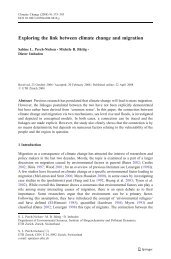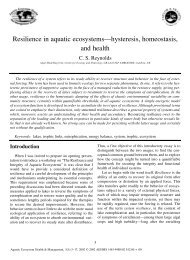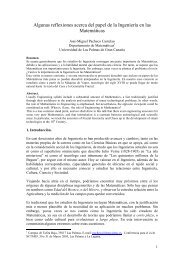5.2.2 Planar Andronov-Hopf bifurcation
5.2.2 Planar Andronov-Hopf bifurcation
5.2.2 Planar Andronov-Hopf bifurcation
Create successful ePaper yourself
Turn your PDF publications into a flip-book with our unique Google optimized e-Paper software.
5.2. ONE-PARAMETER LOCAL BIFURCATIONS IN ODES 141<br />
ρ 1<br />
α < 0<br />
α > 0<br />
α = 0<br />
(0)<br />
ρ (α)<br />
0<br />
ρ 0<br />
Figure 5.9: Fixed points of the return map.<br />
limit cycle of the system, we can conclude that system (5.20) (or equation (5.19))<br />
with any O(|z| 4 ) terms has a unique (stable) limit cycle bifurcating from the origin<br />
and existing for α > 0 as in equation (5.19). Therefore, in other words, higher-order<br />
terms do not affect the limit cycle <strong>bifurcation</strong> in some neighborhood of z = 0 for |α|<br />
sufficiently small.<br />
Step 2 (Construction of a homeomorphism). The established existence and uniqueness<br />
of the limit cycle is enough for all applications. Nevertheless, extra work must<br />
be done to prove the topological equivalence of the phase portraits.<br />
( x 1 , x 2) ( x<br />
~<br />
1 ,<br />
~<br />
x 2)<br />
τ 0 τ 0<br />
ρ 0 ρ 0<br />
Figure 5.10: Construction of the homeomorphism near the <strong>Hopf</strong> <strong>bifurcation</strong>.<br />
Fix α small but positive. The real systems corresponding to (5.17) and (5.19)<br />
both have a unique limit cycle in some neighborhood of the origin. Assume that<br />
the time reparametrization resulting in the constant return time 2π is performed<br />
in (5.17) (see the previous step). Also, apply a linear scaling of the coordinates in<br />
(5.17) such that the point of intersection of the cycle and the horizontal half-axis is<br />
at x 1 = √ α.<br />
Define a map z ↦→ ˜z by the following construction. Take a point z = x 1 + ix 2<br />
and find values (ρ 0 , τ 0 ), where τ 0 is the minimal time required for an orbit of system<br />
(5.19) to approach the point z starting from the horizontal half-axis with ρ = ρ 0 .<br />
Now, take the point on this axis with ρ = ρ 0 and construct an orbit of (5.17) on the






